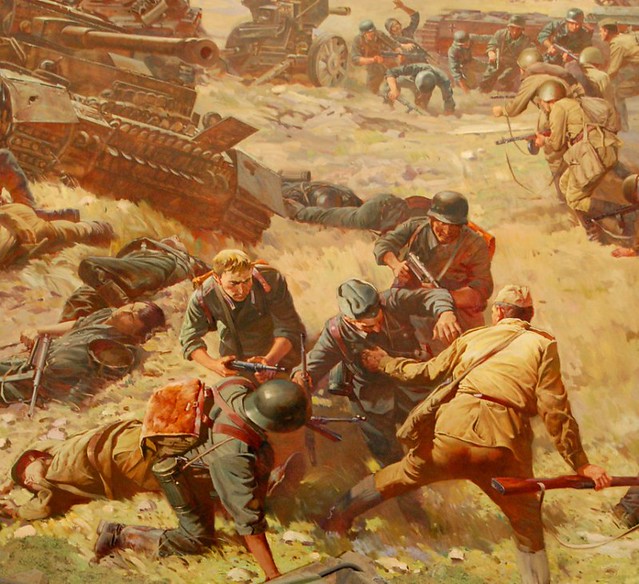|
|
| The war on the Eastern Front, known to Russians as the "Great Patriotic War"
The scene of the largest military confrontation in history. Over the course of four years, more than 400 Red Army and German divisions clashed in a series of operations along a front that extended more than 1,000 miles. Some 27 million Soviet soldiers and civilians and nearly 4 million German troops lost their lives along the Eastern Front during those years of brutality. The warfare there was total and ferocious, encompassing the largest armored clash in history (Battle of Kursk) and the most costly siege on a modern city (nearly 900 days in Leningrad), as well as scorched earth policies, utter devastation of thousands of villages, mass deportations, mass executions, and countless atrocities attributed to both sides. To make things even more complex, forces within the Soviet Union were often fractured among themselves -- early in the war, some groups had even welcomed the Germans and fought against the Red Army, in the hopes that Hitler's troops would liberate them from Stalin. Later, as battles became desperate, Stalin issued Order No. 227 -- "Not a Step Back!" -- which forbid Soviet forces from retreating without direct orders. Commanders who sought to pull back faced tribunals, and foot soldiers faced "blocking detachments" of their own fellow soldiers, ready to gun down any who fled. The photos gathered here cover much of 1942-1943, from the siege of Leningrad to the decisive Soviet victories in Stalingrad and Kursk. The vast scale of the warfare is nearly unimaginable, and nearly impossible to capture in a handful of images, so take these as a mere glimpse of the horrors of the Eastern Front. Sometime in the Autumn of 1942, Soviet soldiers advance through the rubble of Stalingrad. (Georgy Zelma/Waralbum.ru)
The commander of a Cossack unit on active service in the Kharkov region, Ukraine, on June 21, 1942, watching the progress of his troops. (AP Photo) #
The crew of a German anti-tank gun, ready for action at the Russian front in late 1942. (AP Photo) #
This photo, taken in the winter months of 1942, shows citizens of Leningrad as they dip for water from a broken main, during the nearly 900-day siege of the Russian city by German invaders. Unable to capture the Leningrad (today known as Saint Petersburg), the Germans cut it off from the world, disrupting utilities and shelling the city heavily for more than two years. (AP Photo) #
A farewell in Leningrad, in the spring of 1942. The German Siege of Leningrad caused widespread starvation among citizens, and lack of medical supplies and facilities made illnesses and injuries far more deadly. Some 1.5 million soldiers and civilians died in Leningrad during the siege - nearly the same number were evacuated, and many of them did not survive the trip due to starvation, illness, or bombing. (Vsevolod Tarasevich/Waralbum.ru) #
Evidence of the bitter street fighting which took place during the occupation of Rostov, Russia by German forces in August of 1942. (AP Photo) #
A German motorized artillery column crossing the Don river by means of a pontoon bridge on July 31, 1942. Wrecked equipment and materiel of all kinds lies strewn around as the crossing is made. (AP Photo) #
A Russian woman watches building burn sometime in 1942. (NARA) #
An execution of Jews in Kiev, carried out by German soldiers near Ivangorod, Ukraine, sometime in 1942. This photo was mailed from the Eastern Front to Germany and intercepted at a Warsaw post office by a member of the Polish resistance collecting documentation on Nazi war crimes. The original print was owned by Tadeusz Mazur and Jerzy Tomaszewski and now resides in Historical Archives in Warsaw. The original German inscription on the back of the photograph reads, "Ukraine 1942, Jewish Action [operation], Ivangorod." #
A German soldier with a machine gun during the Battle of Stalingrad, in Spring of 1942.(Deutsches Bundesarchiv/German Federal Archive) #
German soldiers crossing a Russian River on their tank on August 3, 1942. (AP Photo) #
After having occupied a village on the Leningrad sector in 1942, Soviet forces discovered 38 bodies of Soviet soldiers that had been taken prisoner by the Germans and apparently tortured to death. (AP Photo) #
This picture, received by the Associated Press on September 25, 1942 through a neutral source, shows a bomb falling after it has just left the plane on its descent to Stalingrad below. (AP Photo) #
Three Russian war orphans stand amid the remains of what was once their home, in late 1942. After German forces destroyed the family's house, they took the parents as prisoners, leaving the children abandoned. (AP Photo) #
A German armored car amidst the debris of the Soviet fortress Sevastopol in Ukraine on August 4, 1942. (AP Photo) #
Stalingrad in October of 1942, Soviet soldiers fighting in the ruins of the factory "Red October".(Deutsches Bundesarchiv/German Federal Archive) #
Antitank gun crews of the Red Army prepare to fire against approaching German tank units, on an unknown battlefield, on October 13, 1942, during the German invasion of the Soviet Union. (AP Photo) #
In October of 1942, a German Junkers Ju 87 "Stuka" dive bomber attacks during the Battle of Stalingrad.(Deutsches Bundesarchiv/German Federal Archive) #
A German tank rolls up to its defeated enemy tank which burns near the edge of a patch of woods, somewhere in Russia, on October 20, 1942. (AP Photo) #
German soldiers advance outside Stalingrad late in 1942. (NARA) #
Sometime in the Autumn 1942, a German soldier hangs a Nazi flag from a building in downtown Stalingrad. (NARA) #
While Russian forces drive around behind them, threatening encirclement, the Germans continue their attempt to take Stalingrad. A Stuka raid on the factory district of Stalingrad is seen in this photo, taken on November 24, 1942.(AP Photo) #
A scene of devastation as an abandoned horse stands among the ruins of Stalingrad in December of 1942. (AP Photo) #
A tank cemetery which the Germans are stated to have established at Rzhev on December 21, 1942. Some 2,000 tanks were said to be in this cemetery in various stages of disrepair. (AP Photo) #
German troops pass through a wrecked generating station in the factory district of Stalingrad, on December 28, 1942.(AP Photo) #
Ruins of part of the city of Stalingrad, on November 5, 1942, following huge battles, with wrecked shells of buildings on either side. (AP Photo) #
Standing in the backyard of an abandoned house in the outskirts of the besieged city of Leningrad, a rifleman of the Red Army aims and fires his machine gun at German positions on December 16, 1942. (AP Photo) #
In January of 1943, a Soviet T-34 tank roars through the Square of Fallen Fighters in Stalingrad.(Georgy Zelma/Waralbum.ru) #
Soviet soldiers in camouflage winter uniforms line up along the roof of a house in Stalingrad, in January of 1943.(Deutsches Bundesarchiv/German Federal Archive) #
Soviet soldiers find cover in piles of rubble from blasted buildings while engaging German forces in street fighting on the outskirts of Stalingrad in early 1943. (AP Photo) #
German troops involved in street fighting in the destroyed streets of Stalingrad in early 1943. (AP Photo) #
Red Army soldiers in camouflage gear on a snow-covered battlefield, somewhere along the German-Russian war front, as they advance against German positions on March 3, 1943. (AP Photo) #
Soviet infantrymen move across snow-covered hills around Stalingrad, on their advance to lift the German siege of the city in early 1943. The Red Army eventually encircled the German Sixth Army, trapping nearly 300,000 German and Romanian soldiers in a narrow pocket. (AP Photo) #
In February of 1943, a Soviet soldier stands guard behind a captured German soldier. Months after being encircled by the Soviets in Stalingrad, the remnants of the German Sixth Army surrendered, after fierce fighting and starvation had already claimed the lives of some 200,000. (Deutsches Bundesarchiv/German Federal Archive) #
Germany's Field Marshal Friedrich Paulus at Red Army Headquarters for interrogation at Stalingrad, Russia, on March 1, 1943. Paulus was the first German Field Marshal taken prisoner in the war, defying Hitler's expectations that he fight until death (or take his own life in defeat). Paulus eventually became a vocal critic of the Nazi regime while in Soviet captivity, and later acted as a witness for the prosecution at the Nuremberg trials. (AP Photo) #
Red Army soldiers in a trench as a Russian T-34 tank passes over them in 1943, during the Battle of Kursk.(Mark Markov-Grinberg/Waralbum.ru) #
Bodies of dead German soldiers lie sprawled across a roadside southwest of Stalingrad, on April 14, 1943. (AP Photo) #
Soviet soldiers, on their backs, launch a volley of bullets at enemy aircraft in June of 1943. (Waralbum.ru) #
In mid-July of 1943, "Tiger" tanks of the German Army during the heavy fighting south of Orel, during the Battle of Kursk. From July until August of 1943, the region around Kursk would see the largest series of armored battles in history, as Germans brought some 3,000 of their tanks to engage more than 5,000 Soviet tanks.(Deutsches Bundesarchiv/German Federal Archive) #
Huge numbers of German tanks concentrate for a new attack on Soviet fortifications on July 28, 1943, during the Battle of Kursk. After taking months to prepare for the offensive, German forces fell far short of their objectives - the Soviets, having been aware of their plans, had built massive defenses. After the German defeat at Kursk, the Red Army would effectively have the upper hand for the rest of the war. (AP Photo) #
German soldiers march before a "Tiger" tank during the Battle of Kursk in June or July of 1943.(Deutsches Bundesarchiv/German Federal Archive) #
A Russian anti-tank gun crew advances towards the German positions under cover of a smoke screen, somewhere in Russia, on July 23, 1943. (AP Photo) #
Captured German tanks southwest of Stalingrad, shown on April 14, 1943. (AP Photo) #
A Soviet lieutenant hands cigarettes to German prisoners somewhere near Kursk, in July of 1943.(Michael Savin/Waralbum.ru) #
The ruins of Stalingrad -- nearly completely destroyed after some six months of brutal warfare -- seen from an aircraft after the end of hostilities, in late 1943. (Michael Savin/Waralbum.ru) |




















































